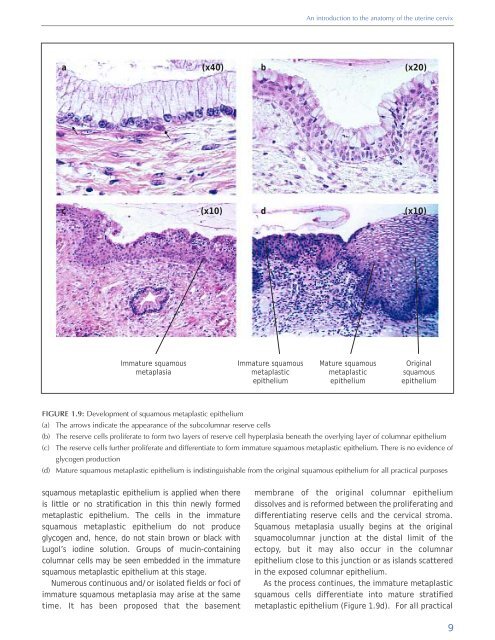Colposcopy and Treatment of Cervical Intraepithelial Neoplasia - RHO
Colposcopy and Treatment of Cervical Intraepithelial Neoplasia - RHO
Colposcopy and Treatment of Cervical Intraepithelial Neoplasia - RHO
You also want an ePaper? Increase the reach of your titles
YUMPU automatically turns print PDFs into web optimized ePapers that Google loves.
An introduction to the anatomy <strong>of</strong> the uterine cervix<br />
a<br />
(x40)<br />
b<br />
(x20)<br />
c<br />
(x10)<br />
d<br />
(x10)<br />
Immature squamous<br />
metaplasia<br />
Immature squamous<br />
metaplastic<br />
epithelium<br />
Mature squamous<br />
metaplastic<br />
epithelium<br />
Original<br />
squamous<br />
epithelium<br />
FIGURE 1.9: Development <strong>of</strong> squamous metaplastic epithelium<br />
(a) The arrows indicate the appearance <strong>of</strong> the subcolumnar reserve cells<br />
(b) The reserve cells proliferate to form two layers <strong>of</strong> reserve cell hyperplasia beneath the overlying layer <strong>of</strong> columnar epithelium<br />
(c) The reserve cells further proliferate <strong>and</strong> differentiate to form immature squamous metaplastic epithelium. There is no evidence <strong>of</strong><br />
glycogen production<br />
(d) Mature squamous metaplastic epithelium is indistinguishable from the original squamous epithelium for all practical purposes<br />
squamous metaplastic epithelium is applied when there<br />
is little or no stratification in this thin newly formed<br />
metaplastic epithelium. The cells in the immature<br />
squamous metaplastic epithelium do not produce<br />
glycogen <strong>and</strong>, hence, do not stain brown or black with<br />
Lugol’s iodine solution. Groups <strong>of</strong> mucin-containing<br />
columnar cells may be seen embedded in the immature<br />
squamous metaplastic epithelium at this stage.<br />
Numerous continuous <strong>and</strong>/or isolated fields or foci <strong>of</strong><br />
immature squamous metaplasia may arise at the same<br />
time. It has been proposed that the basement<br />
membrane <strong>of</strong> the original columnar epithelium<br />
dissolves <strong>and</strong> is reformed between the proliferating <strong>and</strong><br />
differentiating reserve cells <strong>and</strong> the cervical stroma.<br />
Squamous metaplasia usually begins at the original<br />
squamocolumnar junction at the distal limit <strong>of</strong> the<br />
ectopy, but it may also occur in the columnar<br />
epithelium close to this junction or as isl<strong>and</strong>s scattered<br />
in the exposed columnar epithelium.<br />
As the process continues, the immature metaplastic<br />
squamous cells differentiate into mature stratified<br />
metaplastic epithelium (Figure 1.9d). For all practical<br />
9
















